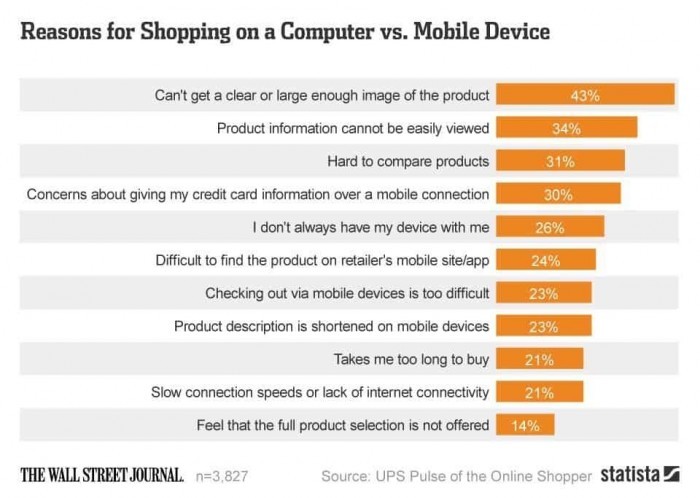Survey shows that risk of making wrong purchase due to lack of information is behind low take up of mobile shopping
 Online retail is still small in comparison with real world shopping. The vast majority of our purchases are made in bricks and mortar stores. And in spite of the dramatic rise in the use of tablets and smartphones in recent years, the amount of shopping we do on these devices is tiny in comparison with what we do on desktop computers. As a result, the amount of mobile shopping that takes place is frankly irrelevant.
Online retail is still small in comparison with real world shopping. The vast majority of our purchases are made in bricks and mortar stores. And in spite of the dramatic rise in the use of tablets and smartphones in recent years, the amount of shopping we do on these devices is tiny in comparison with what we do on desktop computers. As a result, the amount of mobile shopping that takes place is frankly irrelevant.
Yet in spite of the hype about “shopping wherever you are”, only £3bn worth of sales were clocked up on mobiles last year, out of around £90bn of all online shopping – which represents only about 5% of all shopping. So, the extent of mobile shopping is tiny. Furthermore, over 80% of the mobile shopping was done on tablets, meaning that mobile phone shopping actually represents 0.0033% of shopping. Why are we getting in a lather about it? Even if we doubled the amount of mobile shopping, it wouldn’t be noticed by retailers very much. In fact, the kind of figures for mobile shopping are rounding errors on their daily accounts.
A new study shows us why mobile shopping isn’t good enough. It is nothing to do with retailers not taking up the opportunity. It is nothing to do with lack of responsive sites. It is to do with people.
What the survey reveals is that most people do not shop on a mobile device because they cannot see a big enough picture of what they want to buy. And why do they want to see a big picture? To make sure they are buying the right thing – to reduce their risk of purchasing the wrong item.
Reducing the risk of purchase
When we shop whether it is online or in the real world we are constantly seeking to reduce the risk of purchase. We want to make sure we avoid having to ask for our money back or to be disappointed in any way. In real world shops we pick things up, look all around them, feel them and so on. However, online we can’t do this, so we look at as many pictures as possible and we download things like data sheets and try to get as much information as we can.
On a large screen on a desktop computer we can do this all easily. But on a mobile device it is difficult to see things on a small screen. Indeed, this explains why over 80% of mobile shopping is done on tablets, not phones. Screen size is a key factor in helping us acquire the information which reduces our risk of purchase.
Important signal to online retailers
This study, though, tells us more than just about shopping on a mobile. Almost all of the reasons given in the study are about risk reduction – the need for more information, the need for long product descriptions and the need for being able to make comparisons.
The more information you give about whatever you sell online, the better. That means having lots of images, lengthy descriptions and plenty of comparisons to alternative products you sell. The more you help people reduce their perceived risk of purchase, the more they will buy.

